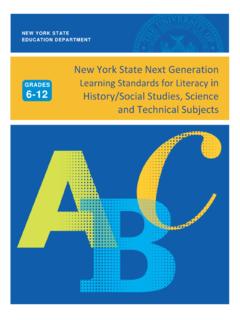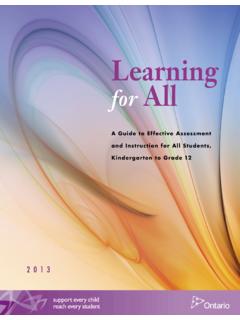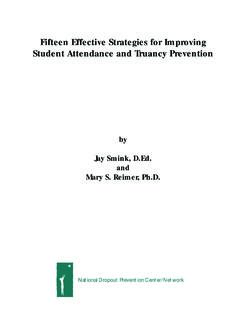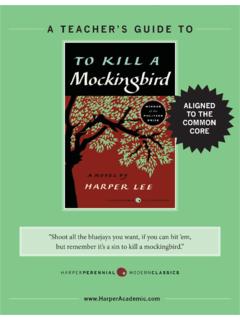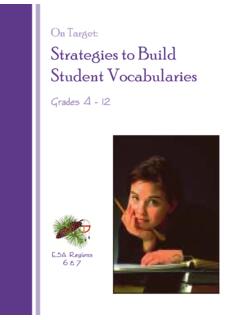Transcription of Teaching Academic Content and Literacy to English …
1 EDUCATOR'S PRACTICE guide WHAT WORKS CLEARINGHOUSE . Teaching Academic Content and Literacy to English Learners in Elementary and Middle School NCEE 2014-4012. DEPARTMENT OF EDUCATION. The Institute of Education Sciences (IES) publishes practice guides in education to bring the best available evidence and expertise to bear on current challenges in education. Authors of practice guides combine their expertise with the available findings of rigorous research to develop specific recommendations for addressing these challenges. The authors rate the strength of the research evidence supporting each of their recommendations. See Appendix A for a full description of practice guides. The goal of this practice guide is to offer educators specific, evidence-based recommendations that address the challenge of Teaching English learners in the elementary and middle grades: building their English language proficiency while simultaneously building Literacy , numeracy skills, and Content knowledge of social studies and science.
2 The guide provides practical and coherent information on critical topics related to Literacy instruction for English learners, and is based on the best available evidence as judged by the authors. Practice guides published by IES are available on our website by selecting Practice Guides . at IES Practice guide Teaching Academic Content and Literacy to English Learners in Elementary and Middle School April 2014. Panel Research Staff Scott Baker (Chair) Russell Gersten Executive Director, Center on Research and Joseph Dimino Evaluation, Southern Methodist University Madhavi Jayanthi Kelly Haymond Esther Geva Rebecca Newman-Gonchar Professor, University of Toronto Instructional Research Group Michael J. Kieffer Associate Professor, New York University Project Officers Joy Lesnick Nonie Lesaux Diana McCallum Professor, Harvard University Institute of Education Sciences Sylvia Linan-Thompson Associate Professor, University of Texas at Austin Joan Morris Teacher Specialist, Pasadena Unified School District C.
3 Patrick Proctor Associate Professor, Boston College Randi Russell Curriculum Support Specialist, Miami-Dade Public Schools NCEE 2014-4012. DEPARTMENT OF EDUCATION. This report was prepared for the National Center for Education Evaluation and Regional Assistance, Institute of Education Sciences, under Contract ED-IES-12-C-0016 by Instructional Research Group. Disclaimer The opinions and positions expressed in this practice guide are those of the authors and do not nec- essarily represent the opinions and positions of the Institute of Education Sciences or the De- partment of Education. This practice guide should be reviewed and applied according to the specific needs of the educators and education agencies using it, with full realization that it represents the judgments of the review panel regarding what constitutes sensible practice, based on the research that was available at the time of publication. This practice guide should be used as a tool to assist in decision making rather than as a cookbook.
4 Any references within the document to specific edu- cation products are illustrative and do not imply endorsement of these products to the exclusion of other products that are not referenced. Department of Education Arne Duncan Secretary Institute of Education Sciences John Q. Easton Director National Center for Education Evaluation and Regional Assistance Ruth Curran Neild Commissioner April 2014. This report is in the public domain. Although permission to reprint this publication is not necessary, the citation should be as follows: Baker, S., Lesaux, N., Jayanthi, M., Dimino, J., Proctor, C. P., Morris, J., Gersten, R., Haymond, K., Kieffer, M. J., Linan-Thompson, S., & Newman-Gonchar, R. (2014). Teaching Academic Content and Literacy to English learners in elementary and middle school (NCEE 2014-4012). Washington, DC: National Center for Education Evaluation and Regional Assistance (NCEE), Institute of Education Sciences, Department of Education. Retrieved from the NCEE website: This report is available on the IES website at and Alternate Formats On request, this publication can be made available in alternate formats, such as Braille, large print, or CD.
5 For more information, contact the Alternate Format Center at (202) 260-0852 or (202) 260-0818. Table of Contents Teaching Academic Content and Literacy to English Learners in Elementary and Middle School Table of Contents Acknowledgements.. 1. Introduction to the Teaching Academic Content and Literacy to English Learners in Elementary and Middle School Practice guide .. 2. Overview of Recommendations.. 6. Institute of Education Sciences Levels of Evidence for Practice Guides.. 8. Recommendation 1. Teach a set of Academic vocabulary words intensively across several days using a variety of instructional activities .. 13. Recommendation 2. Integrate oral and written English language instruction into Content - area Teaching .. 31. Recommendation 3. Provide regular, structured opportunities to develop written language skills.. 47. Recommendation 4. Provide small-group instructional intervention to students struggling in areas of Literacy and English language development .. 59. Glossary.
6 69. Appendix A. Postscript from the Institute of Education Sciences.. 72. Appendix B. About the Panel and Research Staff.. 74. Appendix C. Disclosure of Potential Conflicts of Interest.. 79. Appendix D. Rationale for Evidence Ratings .. 80. References.. 104. ( iii ). Table of Contents (continued). List of Tables Table 1. Recommendations and corresponding levels of evidence .. 7. Table 2. Institute of Education Sciences levels of evidence for practice guides.. 10. Table Studies providing evidence for Recommendation 1 ( Academic vocabulary).. 85. Table Studies providing evidence for Recommendation 2 ( Content -area Teaching ).. 90. Table Studies providing evidence for Recommendation 3 (written language skills) .. 94. Table Studies providing evidence for Recommendation 4 (small-group instructional intervention).. 98. List of Exhibits Exhibit Academic vocabulary defined .. 14. Exhibit Example of an appropriate text for Academic vocabulary instruction.. 15. Exhibit Ms. Gomez's selection of Academic vocabulary for in-depth instruction.
7 17. Exhibit Word map.. 19. Exhibit Sample activity for clarifying words with multiple meanings .. 20. Exhibit Ms. Ambrosi's lesson on using word parts to understand word meaning.. 23. Exhibit Rewriting sentences using different forms of the root words.. 24. Exhibit Sample lesson cycle to teach a small set of Academic vocabulary words in depth. 24. Exhibit An example in anchoring instruction using video .. 33. Exhibit A sample science lesson using video clips and graphic organizers to anchor and make sense of Content .. 34. Exhibit Text for a history lesson on Aztec civilization .. 38. Exhibit Mrs. Prinz's selection of appropriate words to teach in her class.. 39. Exhibit Sample science lesson on the properties of solids.. 42. Exhibit Text-based writing instruction (spanning 3 4 lessons).. 49. Exhibit Writing framework .. 50. Exhibit Sentence starters for text-based analytical writing.. 51. ( iv ). Table of Contents (continued). Exhibit An example of grading student work based on a rubric.
8 53. Exhibit Instruction in text-based writing activity.. 54. Exhibit Addressing Literacy and language needs of struggling English learners.. 63. Exhibit An example of incorporating vocabulary in instructional interventions .. 65. Exhibit Sample vocabulary prompts.. 65. Exhibit Teacher thinking aloud the answer to an inferential question.. 66. (v). Acknowledgments T he panel appreciates the efforts of Russell Gersten, Joseph Dimino, Madhavi Jayanthi, Kelly Haymond, and Rebecca Newman-Gonchar for coordinating the panel's efforts, managing and summarizing the available research, and drafting the guide . The panel would also like to thank the following WWC-certified reviewers for reviewing studies: Laurie Bozzi, Marc Moss, Linda Caswell, Anne Wolf, Yeqin He, Katherine Gan, and Eleanor Harvill, from Abt Associates; Nick Gage from University of Florida; Tran Keys and Eric Rolfhus from Instructional Research Group; and Dan Player from University of Virginia. The panel extends thanks to Pamela Foremski, Christopher Tran, and Jo Ellen Kerr from the Instructional Research Group for their research and administrative assistance, and to Jonathan Cohen for his editorial assistance.
9 Scott Baker Esther Geva Michael J. Kieffer Nonie Lesaux Sylvia Linan-Thompson Joan Morris C. Patrick Proctor Randi Russell (1). Introduction Introduction to the Teaching Academic Content and Literacy to English Learners in Elementary and Middle School Practice guide Why Update the Earlier English expand the scope of the original English learner practice guide . The concept of aca- Learner Practice guide ? demic language and, in particular, Academic vocabulary,5 plays a large role in the Common effective Literacy and English Language Core State Standards for English Language Instruction for English Learners in the Elemen- Researchers and developers have been tary Grades: A Practice guide , published in working on innovative methods to teach both 2007, was the very first IES practice guide Academic vocabulary and Content material in This earlier guide focused solely science, history, and mathematics to English on research conducted up to 2005. As many learners in the context of regular classroom readers will recall, the major emphasis in Writing is another area that is education at that time was Teaching beginning increasingly emphasized, in part because of reading according to evidence-based prac- its large role in the Common Core.
10 Research tice, using a variety of interventions to help efforts have also focused on addressing the students who were likely to struggle. This needs of middle school English learners. The emphasis on early reading intervention was original English learner practice guide was reflected in Reading First,2 numerous state thus updated to correspond with the focus in initiatives,3 and special education the field on improving Academic vocabulary, writing, and Content -area learning of English As a result, the 2007 English learner practice learners at both the elementary and middle guide stressed instruction in beginning read- grades. The expertise and experience of the ing. The guide emphasized types of screening panel charged with writing the updated prac- tools that could be used with English learners tice guide reflect the guide 's expanded scope. and the principles that underlie effective liter- acy interventions for this population, especially in the primary grades. Also addressed in the What Is the Scope of the earlier practice guide were recommendations Updated Practice guide ?





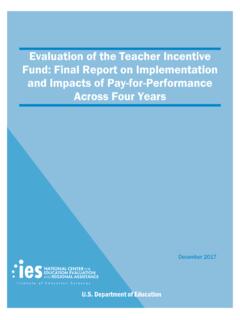




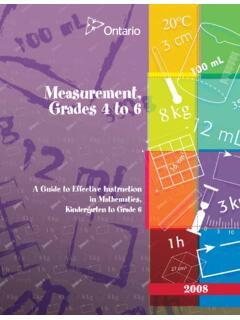
![The Ontario Curriculum, Grades 1-8, Language [revised] 2006](/cache/preview/d/5/3/5/d/c/7/4/thumb-d535dc7439a04910d8a17bf7f1d6b83f.jpg)
